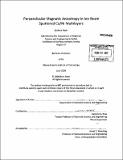| dc.contributor.advisor | Caroline A. Ross. | en_US |
| dc.contributor.author | Rasin, Boris | en_US |
| dc.contributor.other | Massachusetts Institute of Technology. Dept. of Materials Science and Engineering. | en_US |
| dc.date.accessioned | 2010-09-01T16:23:56Z | |
| dc.date.available | 2010-09-01T16:23:56Z | |
| dc.date.copyright | 2009 | en_US |
| dc.date.issued | 2009 | en_US |
| dc.identifier.uri | http://hdl.handle.net/1721.1/58071 | |
| dc.description | Thesis (S.B.)--Massachusetts Institute of Technology, Dept. of Materials Science and Engineering, 2009. | en_US |
| dc.description | Cataloged from PDF version of thesis. | en_US |
| dc.description | Includes bibliographical references (p. 34-35). | en_US |
| dc.description.abstract | Co/Ni multilayers display perpendicular magnetic anisotropy and have applications in magnetic devices that could lead to a large increase in the density of magnetic storage. Co/Ni 10-(2 Å Co/ 8Å Ni) and 10-(2 Å Co/ 4 Å Ni) multilayers were deposited with ion beam sputtering on either ion beam sputtered copper or direct current magnetron sputtered gold buffer layers of various thicknesses. The effect of the the roughness and the degree of (1 1 1) texture of the buffer layers and the multilayers on the perpendicular magnetic anisotropy of the deposited multilayers was examined. In addition the effect of the deposition method used to fabricate the samples, ion beam sputtering, was analyzed. The magnetic behavior of the multilayers was examined with alternating gradient magnetometry and vibrating sample magnetometery, the structure of the buffer layers and the multilayers was characterized with X-ray diffraction, and the roughness of the surface of the multilayers was characterized with atomic force microscopy. None of the deposited films showed perpendicular magnetic anisotropy and instead showed parallel magnetic anisotropy which was found to have occurred for every sample due to either a low degree of (1 1 1) texture in the buffer layer and the Co/Ni multilayer, a too high degree of roughness in the buffer layer and the Co/Ni multilayer or a combination of these two factors. In addition it was hypothesized that as the samples were deposited with sputtering, diffusion and alloying at the multilayer interfaces may have contributed to the multilayers having parallel magnetic anisotropy instead of perpendicular magnetic anisotropy. | en_US |
| dc.description.statementofresponsibility | by Boris Rasin. | en_US |
| dc.format.extent | 35 p. | en_US |
| dc.language.iso | eng | en_US |
| dc.publisher | Massachusetts Institute of Technology | en_US |
| dc.rights | M.I.T. theses are protected by
copyright. They may be viewed from this source for any purpose, but
reproduction or distribution in any format is prohibited without written
permission. See provided URL for inquiries about permission. | en_US |
| dc.rights.uri | http://dspace.mit.edu/handle/1721.1/7582 | en_US |
| dc.subject | Materials Science and Engineering. | en_US |
| dc.title | Perpendicular magnetic anisotropy in ion beam sputtered Co/Ni multilayers | en_US |
| dc.type | Thesis | en_US |
| dc.description.degree | S.B. | en_US |
| dc.contributor.department | Massachusetts Institute of Technology. Department of Materials Science and Engineering | |
| dc.identifier.oclc | 630088568 | en_US |
